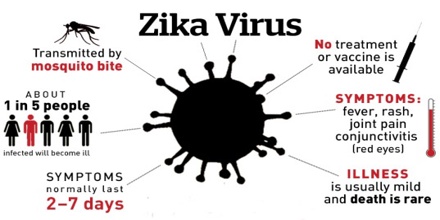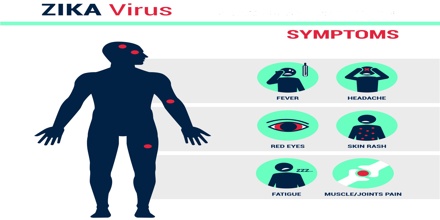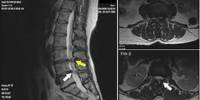Zika Virus (ZIKV)
Zika virus is a mosquito-borne flavivirus that was first identified in Uganda in 1947 in monkeys through a network that monitored yellow fever. It was later identified in humans in 1952 in Uganda and the United Republic of Tanzania. Outbreaks of Zika virus disease have been recorded in Africa, the Americas, Asia and the Pacific. From the 1960s to 1980s, human infections were found across Africa and Asia, typically accompanied by mild illness. The first large outbreak of disease caused by Zika infection was reported from the Island of Yap (Federated States of Micronesia) in 2007. In July 2015 Brazil reported an association between Zika virus infection and Guillain-Barré syndrome. In October 2015 Brazil reported an association between Zika virus infection and microcephaly.

In January 2016, the United States Centers for Disease Control and Prevention (CDC) issued travel guidance on affected countries, including the use of enhanced precautions, and guidelines for pregnant women including considering postponing travel. Other governments or health agencies also issued similar travel warnings, while Colombia, the Dominican Republic, Puerto Rico, Ecuador, El Salvador, and Jamaica advised women to postpone getting pregnant until more is known about the risks.
The Zika virus belongs to the Flaviviridae family and the Flavivirus genus, and is thus related to the dengue, yellow fever, Japanese encephalitis, and West Nile viruses. Like other flaviviruses, Zika virus is enveloped and icosahedral and has a nonsegmented, single-stranded, 10 kilobase positive-sense RNA genome. It is most closely related to the Spondweni virus and is one of the two known viruses in the Spondweni virus clade.
There are two Zika lineages: the African lineage and the Asian lineage. Phylogenetic studies indicate that the virus spreading in the Americas is 89% identical to African genotypes, but is most closely related to the Asian strain that circulated in French Polynesia during the 2013–2014 outbreak.
Zika can be transmitted from men and women to their sexual partners; however, most cases involve transmission from symptomatic men to women. As of April 2016, sexual transmission of Zika has been documented in six countries – Argentina, Chile, France, Italy, New Zealand, and the United States – during the 2015 outbreak.
Since October 2016, the CDC has advised men who have traveled to an area with Zika should use condoms or not have sex for at least six months after their return, even if they never develop symptoms, because the virus is transmissible in semen.

Based on a systematic review of the literature up to 30 May 2016, WHO has concluded that Zika virus infection during pregnancy is a cause of congenital brain abnormalities, including microcephaly; and that Zika virus is a trigger of Guillain-Barré syndrome. Intense efforts are continuing to investigate the link between Zika virus and a range of neurological disorders, within a rigorous research framework. The virus has caused panic in Brazil since it first appeared there in May 2015. More than 2,100 babies in Brazil have been born with microcephaly or other birth defects linked to Zika. Brazil and several other nations have advised women to postpone pregnancy.
Signs and Symptoms of Zika
The disease can cause fever, rash, joint pain, and redness in the whites of the eye (conjunctivitis, or pinkeye). But most people won’t know they have it.
“Only about 1 in 5 people with the virus will exhibit symptoms,” says Adalja. “The vast majority have no symptoms at all.”
Symptoms can appear anywhere from 3 to 14 days after a bite from an infected mosquito, according to the CDC. They can last from several days to about a week.

The most common symptoms of Zika are
- Fever
- Rash
- Joint pain
- Conjunctivitis (red eyes)
Other symptoms include:
- Muscle pain
- Headache
In a report, the CDC describes five types of birth defects, including severe microcephaly, that are unique to Zika or rarely occur with other infections in pregnant women. They are:
- Decreased brain tissue with calcium deposits indicating brain damage
- Damage to the back of the eye
- Limited range of motion in joints, such as clubfoot
- Too much muscle tone, which restricts movement
Those effects in babies are called congenital Zika syndrome.
Transmission and Diagnosis
Zika virus is primarily transmitted to people through the bite of an infected mosquito from the Aedes genus, mainly Aedes aegypti in tropical regions. Aedes mosquitoes usually bite during the day, peaking during early morning and late afternoon/evening. This is the same mosquito that transmits dengue, chikungunya and yellow fever. Sexual transmission of Zika virus is also possible. Other modes of transmission such as blood transfusion are being investigated.
Infection with Zika virus may be suspected based on symptoms and recent history of travel (e.g. residence in or travel to an area with active Zika virus transmission). A diagnosis of Zika virus infection can only be confirmed through laboratory tests on blood or other body fluids, such as urine, saliva or semen.

Treatment and Prevention
Zika virus disease is usually mild and requires no specific treatment. People sick with Zika virus should get plenty of rest, drink enough fluids, and treat pain and fever with common medicines. If symptoms worsen, they should seek medical care and advice. There is currently no vaccine available.
Protection against mosquito bites is a key measure to prevent Zika virus infection. This can be done by wearing clothes (preferably light-coloured) that cover as much of the body as possible; using physical barriers such as window screens or closing doors and windows; sleeping under mosquito nets; and using insect repellent containing DEET, IR3535 or icaridin according to the product label instructions. Special attention and help should be given to those who may not be able to protect themselves adequately, such as young children, the sick or elderly. Travellers and those living in affected areas should take the basic precautions described above to protect themselves from mosquito bites.
It is important to cover, empty or clean potential mosquito breeding sites in and around houses such as buckets, drums, pots, gutters, and used tyres. Communities should support local government efforts to reduce mosquitoes in their locality. Health authorities may also advise that spraying of insecticides be carried out.
















